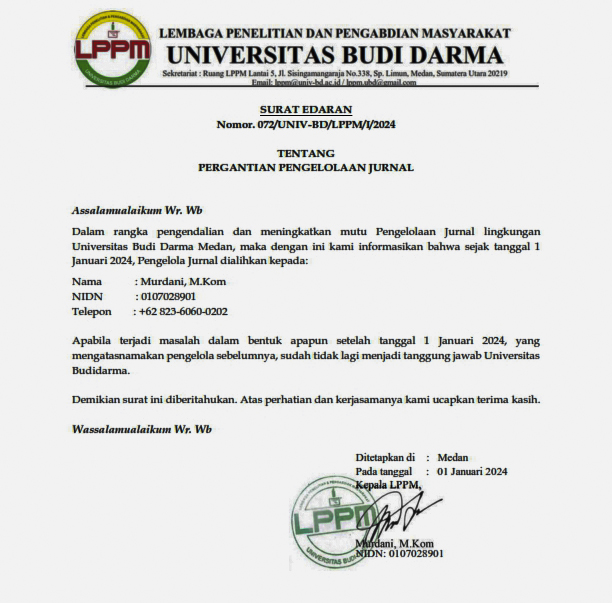Temporal Prediction on Students’ Graduation using Naïve Bayes and K-Nearest Neighbor Algorithm
DOI:
https://doi.org/10.30865/mib.v5i2.2919Keywords:
Classification, Graduation, Student, K-Nearest Neighbor, Naïve Bayes, Learning AnalyticsAbstract
Accreditation is a form of assessment of the feasibility and quality of higher education. One of the accreditation assessment factors is the percentage of graduation on time. A low percentage of on-time graduations can affect the assessment of accreditation of study programs. Predicting student graduation can be a solution to this problem. The prediction results can show that students are at risk of not graduating on time. Temporal prediction allows students and study programs to do the necessary treatment early. Prediction of graduation can use the learning analytics method, using a combination of the naïve bayes and the k-nearest neighbor algorithm. The Naïve Bayes algorithm looks for the courses that most influence graduation. The k-nearest neighbor algorithm as a classification method with the attribute limit used is 40% of the total attributes so that the algorithm becomes more effective and efficient. The dataset used is four batches of Telkom University Informatics Engineering student data involving data index of course scores 1, level 2, level 3, and level 4 data. The results obtained from this study are 5 attributes that most influence student graduation. As well as the results of the presentation of the combination naïve bayes and k-nearest neighbor algorithm with the largest percentage yield at level 1 75.40%, level 2 82.08%, level 3 81.91%, and level 4 90.42%.References
Badan Akreditasi Nasional Perguruan Tinggi, “Akreditasi Perguruan Tinggi Kreteria dan Prosedur 3.0,†pp. 1–18, 2019.
M. Waluyo and L. Pramudhitasari, “Learning Analytics untuk meningkatkan kualitas pembelajaran,†Semin. Nas. Kedua Pendidik. Berkemajuan dan Menggembirakan (The Second Progress. Fun Educ. Semin., 2017.
H. Muhamad, C. A. Prasojo, N. A. Sugianto, L. Surtiningsih, and I. Cholissodin, “Optimasi Naïve Bayes Classifier Dengan Menggunakan Particle Swarm Optimization Pada Data Iris,†J. Teknol. Inf. dan Ilmu Komput., 2017, doi: 10.25126/jtiik.201743251.
T. A. Setiawan, R. S. Wahono, and A. Syukur, “Integrasi Metode Sample Bootstrapping dan Weighted Principal Component Analysis untuk Meningkatkan Performa K Nearest Neighbor pada Dataset Besar,†J. Intell. Syst., 2015.
E. Rohmawan, “Prediksi Kelulusan Mahasiswa Tepat Waktu Menggunakan Metode Desicion Tree Dan Artificial Neural Network,†J. Ilm. Matrik, 2018.
M. K. Sari, Ernawati, and Pranowo, “Kombinasi Metode K-Nearest Neighbor,†Semin. Nas. Teknol. Inf. dan Multimed., 2015.
A. Askari, A. D’Aspremont, and L. El Ghaoui, “Naive feature selection: Sparsity in naive bayes,†arXiv, 2019.
A. D. Sarıyalçınkaya, H. Karal, F. Altinay, and Z. Altinay, “Reflections on Adaptive Learning Analytics,†no. March, pp. 61–84, 2021, doi: 10.4018/978-1-7998-7103-3.ch003.
E. Suhartono, “Systematic Literatur Review ( SLR ): Metode , Manfaat , Dan Tantangan Learning Analytics Dengan Metode Data Mining di Dunia Pendidikan Tinggi,†J. Ilm. INFOKAM, vol. 13, no. 1, pp. 73–86, 2017.
J. Han, M. Kamber, and J. Pei, Data Mining Concept and Tehniques, third edition (3rd ed.). 2012.
I. A. Angreni, S. A. Adisasmita, M. I. Ramli, and S. Hamid, “PENGARUH NILAI K PADA METODE K-NEAREST NEIGHBOR (KNN) TERHADAP TINGKAT AKURASI IDENTIFIKASI KERUSAKAN JALAN,†Rekayasa Sipil, 2019, doi: 10.22441/jrs.2018.v07.i2.01.
R. Arian, A. Hariri, A. Mehridehnavi, A. Fassihi, and F. Ghasemi, “Protein kinase inhibitors’ classification using K-Nearest neighbor algorithm,†Comput. Biol. Chem., 2020, doi: 10.1016/j.compbiolchem.2020.107269.
R. Wijayatun and Y. Sulistyo, “Prediksi Rating Film Menggunakan Metode Naive Bayes,†J. Tek. Elektro Unnes, vol. 8, no. 2, pp. 60–63, 2016, doi: 10.15294/jte.v8i2.7764.
A. Syarifa and M. A. Muslim, “Pemanfaatan Naïve Bayes Untuk Merespon Emosi Dari Kalimat Berbahasa Indonesia,†Unnes J. Math., vol. 4, no. 2, 2015, doi: 10.15294/ujm.v4i2.9706.
H. Annur, “Klasifikasi Masyarakat Miskin Menggunakan Metode Naive Bayes,†Ilk. J. Ilm., 2018, doi: 10.33096/ilkom.v10i2.303.160-165.
Downloads
Published
Issue
Section
License

This work is licensed under a Creative Commons Attribution 4.0 International License
Authors who publish with this journal agree to the following terms:
- Authors retain copyright and grant the journal right of first publication with the work simultaneously licensed under Creative Commons Attribution 4.0 International License that allows others to share the work with an acknowledgment of the work's authorship and initial publication in this journal.
- Authors are able to enter into separate, additional contractual arrangements for the non-exclusive distribution of the journal's published version of the work (e.g., post it to an institutional repository or publish it in a book), with an acknowledgment of its initial publication in this journal.
- Authors are permitted and encouraged to post their work online (e.g., in institutional repositories or on their website) prior to and during the submission process, as it can lead to productive exchanges, as well as earlier and greater citation of published work (Refer to The Effect of Open Access).



